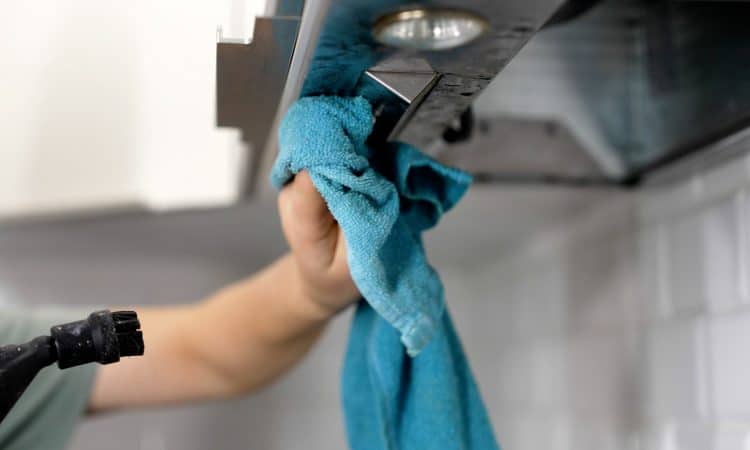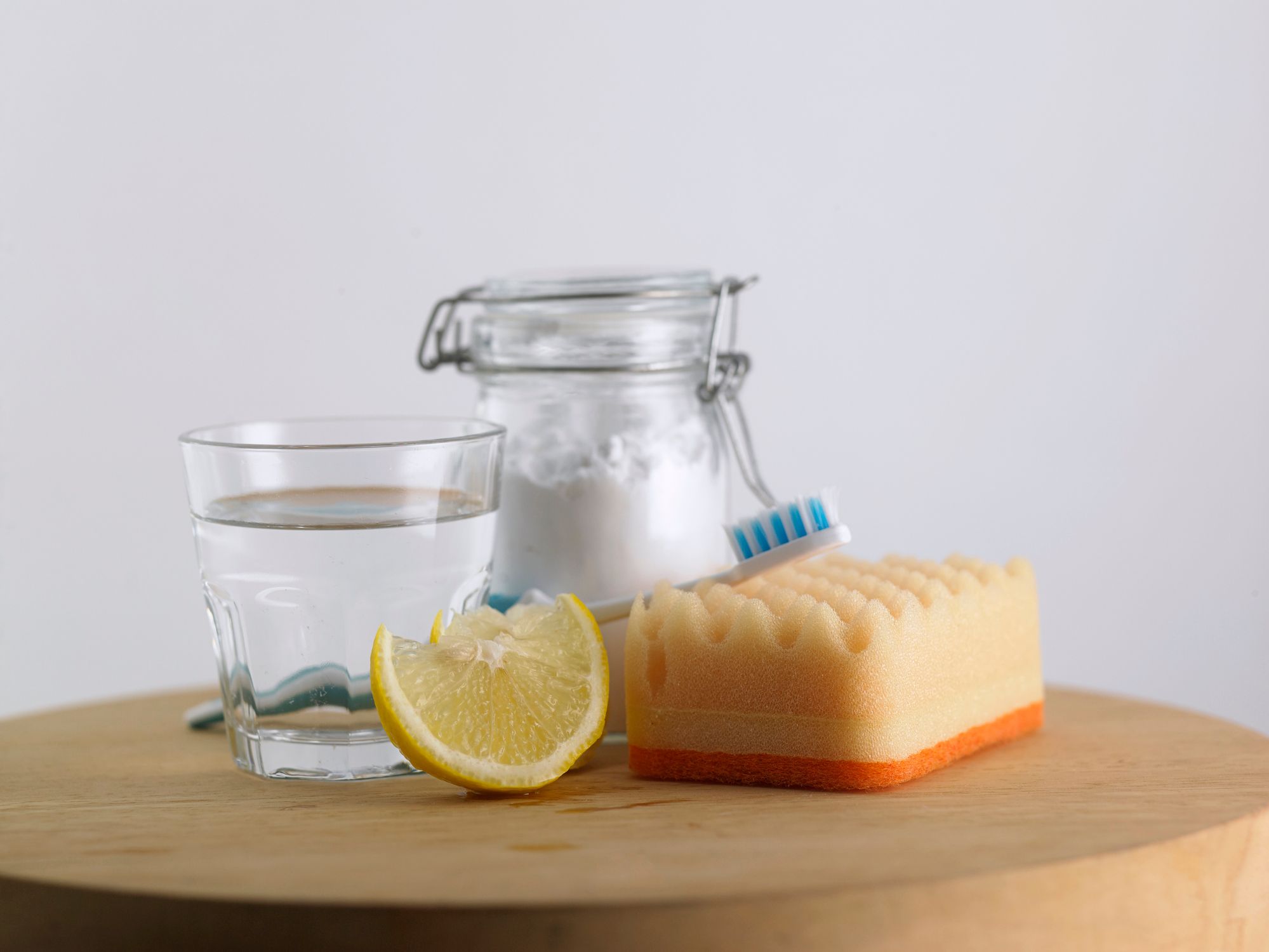
Do you use your extractor hood when cooking? The humming appliance is a real asset to the kitchen, especially when you’re cooking intensely fragrant dishes. It also protects kitchen surfaces from cooking grease – practical!
However, to keep the extractor hood running well for a long time, it needs to be cleaned regularly. When was the last time you did this? Has it been a while? No problem, because with our tips you can easily get rid of the sticky grease.
Cleaning a sticky extractor hood
If you have already removed the filter, this is exactly the right time to clean the remaining surfaces of the extractor hood. Because now you can get at all the dirt from both the outside and the inside.
When cleaning, however, remember not to use abrasive cleaning agents, dishwashing brushes or metal sponges. These can cause scratches.
1. Dishwashing detergent
The liquid detergent is part of every kitchen’s basic equipment for a reason. It is simply totally practical for removing all kinds of stains.
- Mix some dishwashing liquid with warm water. Take a sponge and dip it into the mixture.
- Now go over all surfaces thoroughly.
- Wipe with a wet cloth and dry the extractor hood with a soft cloth.
2. Baking powder
What is suitable for the grease grille also works well for the rest of the extractor hood. Heavy soiling in particular can be removed in no time with this household remedy.
- Mix the powder with a little water to form a paste. Rub this onto the hood.
- After a short exposure time, wipe it off with a wet cloth.
- Then polish the surface with a lint-free cloth.
TipBaking soda also works wonderfully to clean the extractor fan.
3. Lemon
Citric acid is an environmentally friendly and powerful cleaner. The grease remover also makes extractor hoods shine in no time at all.
- Cut a lemon in half and rub the cut surface over the dirty areas.
- Allow the juice to work in briefly. Then wipe it off with warm water.
4. Vegetable oil
This tip sounds counterproductive at first, but it actually works. The oil dissolves the encrusted grease and makes the surface of your extractor hood shine again.
- Put some oil on a piece of kitchen roll.
- Work the oil into the stainless steel in a circular motion.
- Wipe with a little household cleaner.
TipSpecial stainless steel care (e.g. from Würth*) cleans the metal thoroughly and also cares for it. So it shines like new.
Steam cleaner insider tip
A steam cleaner saves you unnecessary scrubbing when cleaning your extractor hood. The hot steam from the appliance dissolves grease and cooking residues in no time at all. As soon as they are liquid, you can wipe them off.
A steam cleaner (buy on Amazon*) is particularly useful for the grease filter. It also softens residues on the extractor hood itself.
- Cover your stove with a few cloths or newspaper.
- If necessary, remove the grease grid or other parts of the hood to reach dirty areas.
- Steam the affected areas with your steam cleaner. Grease and the like should soften quickly.
- Wipe with a damp cloth.
You can also use a steam vacuum cleaner (e.g. from Kärcher). This is the next stage in the development of the steam cleaner, so to speak, and has the advantage that the dirt does not need to be wiped off.
Cleaning the extractor hood filter
The filter of your extractor hood is usually made of metal and is located directly above the stove. It is responsible for removing grease from the air that is drawn in by the extractor hood during cooking. This prevents the fan from becoming greasy and unusable.
The filter gets dirty very quickly. It is a bit of a nuisance to clean. But with the right home remedies, it works quite well.
But first: Remove the grease filter from the holder. You may have to loosen a few small screws to do this. It is also best to cover your stove. This will prevent unnecessary dirt.
1. washing-up liquid
What’s the first thing you reach for when you have to wash greasy pots? That’s right: washing-up liquid. The liquid detergent is also powerful against dirt on your metal filter.
- Pour a mixture of warm water and washing-up liquid into a large bowl or your sink.
- Dip the metal grid into it and leave the solution to work for a while.
- Use a sponge to wipe off the loosened dirt residue. Scrub more stubborn residues with a dishwashing brush.
AlternativelyUse a little grease remover (such as this one from Amazon*). This way, residues don’t stand a chance.
2. baking powder
Baking powder, or alternatively baking soda, is not only an environmentally friendly household remedy, it also has enormous cleaning power! Grandma’s favorite cleaning agent helps you to clean the grease filter of your extractor fan.
- Place the metal grid in your sink, bathtub or a large bucket. Now sprinkle a packet of baking soda over it. Then fill your container with boiling hot water until the filter is covered.
- Leave the mixture to soak for half an hour. This will slowly loosen the dirt.
- Use a cloth to remove the remaining dirt under running water. Finally, dry the filter thoroughly – done!
AlternativelyStir your powder with some liquid in a small bowl to form a paste. Apply this to your filter with a cloth and rinse it off thoroughly after about 10 minutes together with the dirt.
3. dishwasher
Yes, you can also clean your grease filter in the dishwasher, provided it is big enough. The problem is that you have to select a very intensive program with high temperatures to loosen the dirt.
- If your grill is not too dirty, you can place it vertically in the machine and let it wash. However, it is better not to add any additional dishes.
- If your filter is heavily coated with grease, it is best to place it horizontally in the top drawer of the machine. This allows the water to bounce up better and stubborn stains are loosened.
Caution: Make sure that your grille can withstand cleaning in the dishwasher. The manufacturer should provide information on this.
4. oven
You read that right: You can also clean your metal filter using the oven. This heats up the grease residue and makes it easier to remove.
- Place 2-3 layers of baking paper on a baking tray. Place the metal filter on top and “bake” it for about 30-40 minutes at 110 °C.
- The fat liquefies and drips onto the baking tray.
- As soon as the fat has dissolved, you can wash off the remains.

Why do you need to clean the extractor hood?
Why should you actually clean extractor hoods? After all, they are designed to filter grease and other by-products of our cooking. There are several good reasons for this:
- Greasy filters are a fire risk. Grease is highly flammable and should therefore be removed.
- The performance can decrease. Bad odors, grease and oil are not sufficiently absorbed. The kitchen smells unpleasant and a greasy film forms on the furniture.
- The extractor motor can become greasy. It breaks down and has to be replaced. This can cause costs.
- Bacteria and mold spores feel particularly at home in the grease that accumulates on the filters. Germs multiply like crazy in the warm environment.
- The extractor hood can quickly look greasy due to grease splashes and other residues. Cleaning is therefore worthwhile for visual reasons alone.
More reading material: You should urgently clean these items regularly
How often should you clean the extractor hood?
Unfortunately, there is no one-size-fits-all answer to this question. How often you need to clean your extractor hood depends on what and how often you cook.
- If you are a big fan of deep-frying and fry food frequently, you should clean the hood about once a month.
- If your dishes are less greasy, cleaning every three months is sufficient.
- If you don’t like cooking, you should clean once every six months.
In any case, remember not to put off cleaning for too long. The longer the grease sticks to the surfaces, the more scrubbing you have to do.
By the way: Some older models have a grease filter fleece. This must be changed every three to six months. However, this equipment is rather rare nowadays.
Changing the activated charcoal filter
The filters used also differ depending on the extractor hood:
- Exhaust hoods channel odors from the kitchen to the outside via a pipe. They have a metal filter that is cleaned as described above.
- Recirculation hoods return the cleaned air back into the room. An activated charcoal filter is also used for this purpose.
- Hybrid hoods can direct the exhaust air outside or back into the room. This type of extractor hood has both types of filter.
Of course, these filters also need to be cleaned and replaced regularly. You should change them after three to six months. It’s quite simple:
- First remove the grease filter from the hood. This will give you access to the charcoal filter. This is held in place by clips that you can simply release by hand.
- Remove the old filter and install the new one.
Can activated carbon filters also be cleaned?
Yes, some newer models can be cleaned in the dishwasher or with the heat of the oven. It depends on whether the charcoal filter is a disposable or reusable system. However, the standard models must be changed regularly.

